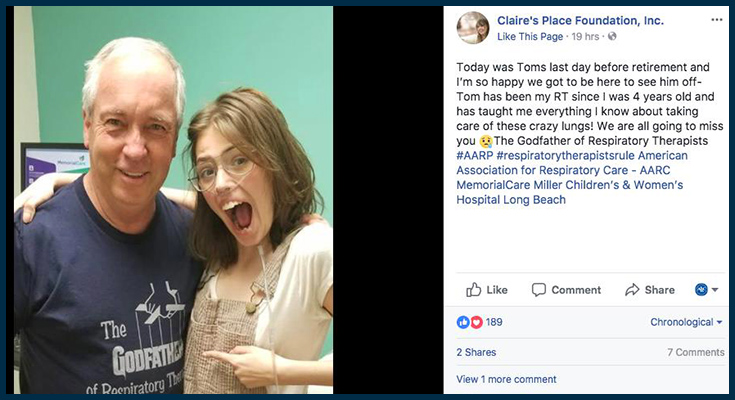
Respiratory therapists often build special bonds with the chronic lung patients they take care of year after year.
Tom Newton, RRT, AE-C, is no exception, and as he got ready to retire a few weeks ago, one of his longtime patients let the world know what he has meant to her.
Claire Wineland — the 20-year-old with cystic fibrosis who wowed crowds during the keynote address at AARC Congress 2017 — used her Claire’s Place Foundation Facebook page to send a special shout-out to Newton.
“Today was Tom’s last day before retirement and I’m so happy we got to be here to see him off,” she wrote. “Tom has been my RT since I was four years old and has taught me everything I know about taking care of these crazy lungs!”
Unlikely RT
In many respects, Tom Newton is an unlikely respiratory therapist.
“I was born with congenital heart disease — tetralogy of fallot — and spent a fair amount of time in the hospital when I was young,” Newton said. ”At the time, I wanted nothing to do with hospitals, needles, the smell of alcohol.”
Fortunately, his heart condition was effectively treated, but unfortunately, he had asthma as well. He was introduced to the profession of respiratory care during his first asthma hospitalization when he was 21, and he was impressed by what his RTs did and how they involved him in his own care.
“I was placed on an old Bird IPPB machine and received Bronkosol,” Newton said. ”I got so familiar with it, I ended up showing the RT students that came to treat me how to use it.”
When he got out of the hospital he approached a family friend who was a nursing professor at Long Beach City College (LBCC) in Long Beach, CA, and her recommendation helped him get into the LBCC respiratory care program. He graduated in 1981 and set out on what would be a 37-year career at Long Beach Memorial Hospital’s Miller Children’s & Women’s Hospital.
He found his niche
Like all students, Newton began his experience with hands-on respiratory care on the adult medical wards. But after doing a rotation in pediatrics he knew he had found his niche.
”You spend a lot of time in their rooms doing therapy, so you get a chance to know them,” he said. ”These kids come in very sick, and most of the time they get better and can go home with a smile on their face.”
Claire Wineland’s mother, Melissa Nordquist Yeager, has seen that time and again with her daughter, and she credits Newton with helping to make it happen.
“Tom and Claire met when she was four years old, full of energy, and it was difficult to get her cooperation for RT treatments,” recalls Nordquist Yeager, who serves as executive director of Claire’s Place Foundation. “I would observe Tom and how he could distract and play around with her until her treatments were done.”
She says Newton showed her how to meet Claire at her level over the years so that she could get the best compliance with care and treatments her daughter was capable of at the time.
“Now as a young adult, they have a wonderful and very funny banter,” she said of Newton and Claire. “He has always added humor and levity to a sometimes scary situation, and Claire really appreciates that.”
On one occasion, Claire recalls, “I was recovering from surgery and my heart rate was off the wall, he sat in my room and taught me this pursed-lipped breathing to calm me down. He did it with me for 25 minutes until my heart rate was back to normal. I’m incredibly grateful to Tom, not just for teaching me how to take care of my lungs, but for always treating me like an active member of my health care team.”
Advocating for RTs
Newton eventually took his own extensive experience with CF patients and used it to advocate for a larger role for RTs on the cystic fibrosis team throughout the country as well, working through the North American Cystic Fibrosis Conference (NACFC).
Newton says he’s seen a multitude of changes in the care of CF patients during his career. New therapies and devices such as PEP, the Vest, vibrating PEP, the Autogenic Drainage Active Cycle of Breathing Technique, IPV, the Vibralung, and hypertonic saline solution — not to mention new drugs such as Pulmozyme, TOBI, and Cayston — have been game changers for his patients.
“When I started taking care of CF patients, life expectancy was around 18,” he said. “Now it has increased to 47 per NACFC patient registry data.”
As a member of his hospital’s CF team since its inception, he strongly believes RTs are key players.
“Our job is not unlike a cheerleader in keeping our patients motivated to do their therapy day in and day out,” he said.
He believes his AARC membership has helped him keep up with all the advances and cites RESPIRATORY CARE as the most valuable membership benefit to him.
“I have used that as a resource throughout my career,” he said. He even published a paper on CF in a 2009 edition of the Journal.
The AARC’s Guide to Aerosol Delivery Devices, now in its 4th edition, is a must-have for him as well.
Lifelong relationships
For Melissa Nordquist Yeager and her family, having Newton there during Claire’s hardest moments has been reassuring.
She knows other families struggling with CF feel the same about their RTs too.
“Every CF patient is different and it is wonderful to build lifelong relationships with your RT team, trusting that they see your child as an individual and can be flexible and even creative in order to achieve the best outcomes,” she said.